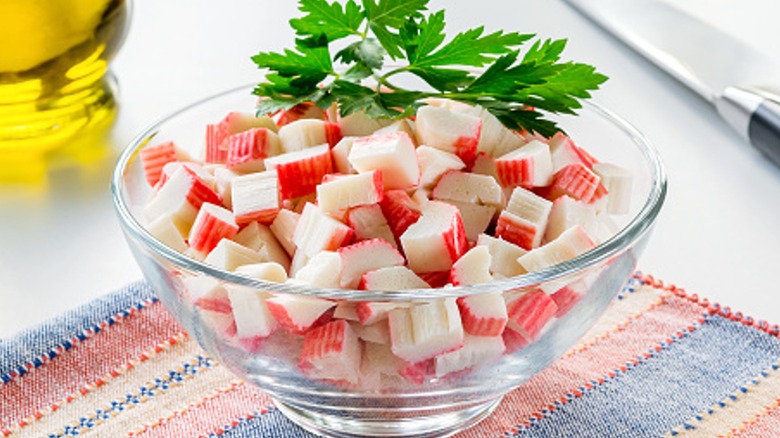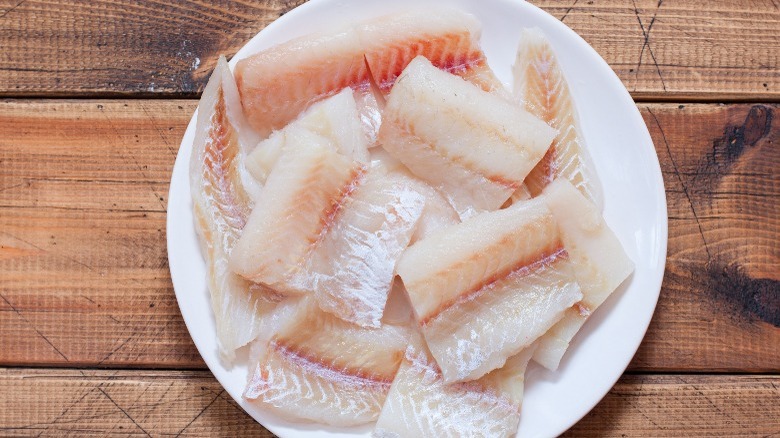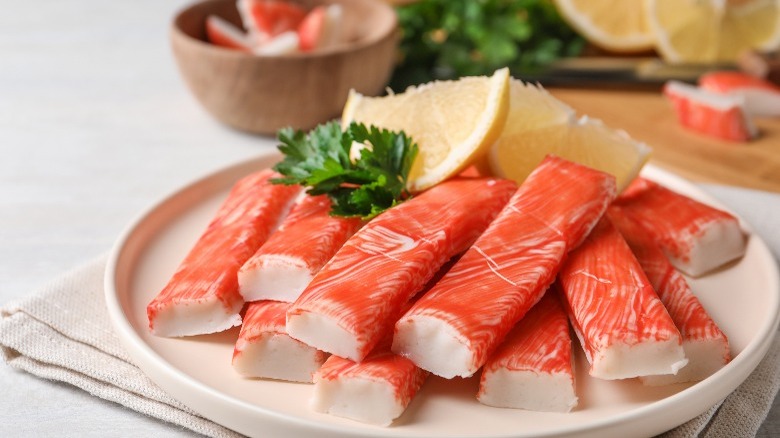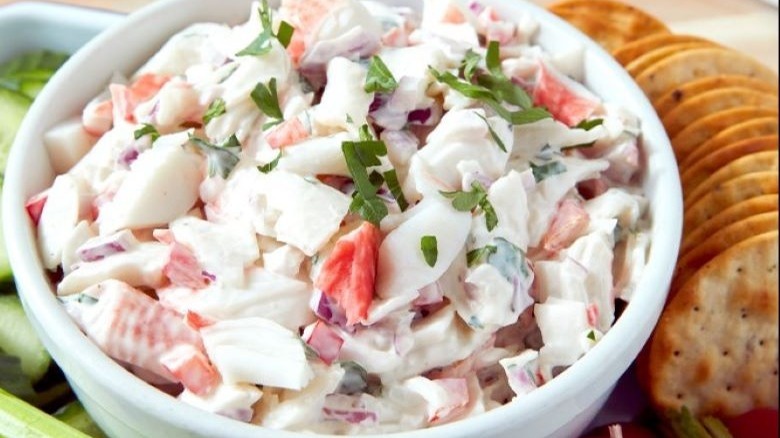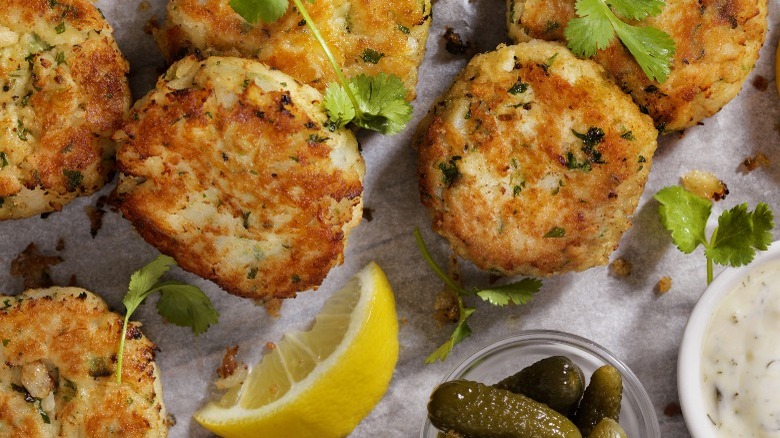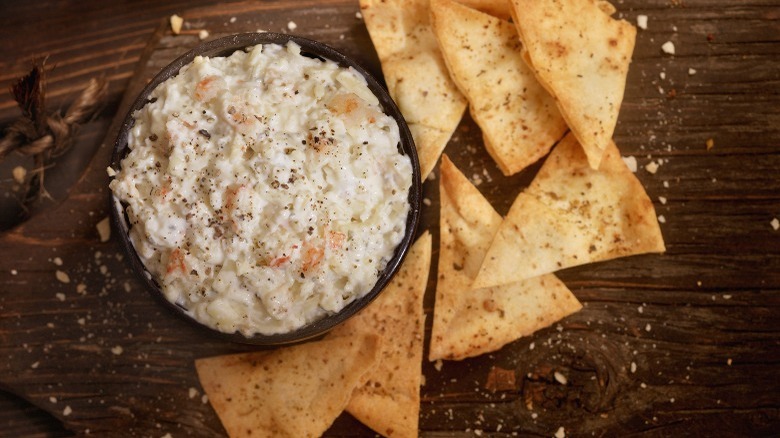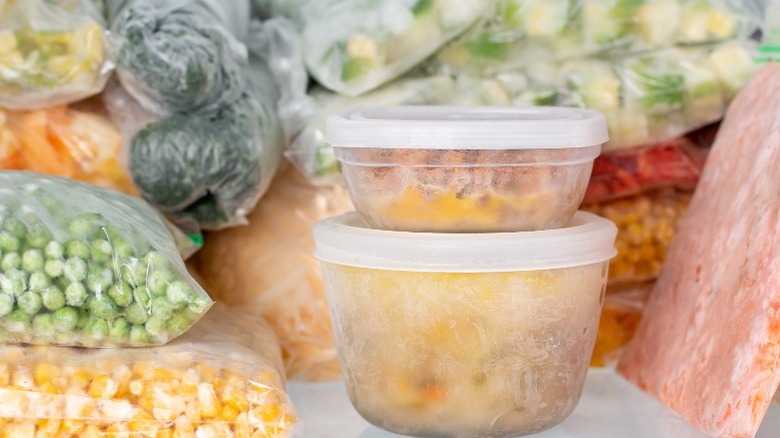13 Mistakes To Avoid When Using Imitation Crab
Real crab meat is considered a delicacy because it's so fluffy, tender, and salty/sweet. But it can be expensive, especially king crab legs — and that's why imitation crab was created. However, even though the taste is comparable, the differences are noticeable. It can be an acceptable substitute, as long as it's handled and prepared without making mistakes.
Imitation crab has been around since the 1970s, when it was invented in Japan. It took about another 10 years for it to make its way here. Since its arrival, you'll usually find it in grocery store seafood departments. But instead of sharing space with the real shellfish, the imitation crab (and its close cousin imitation lobster) might be vacuum-sealed packages in separate refrigerated cases. These products are sold in chunk, stick, and shredded forms. The packages are marked with words like crab sticks, surimi, krab, and imitation crab meat.
It's found in California rolls too, as a substitute for the real stuff. Faux crab is widely used. Oftentimes, you might not even realize that it's in those sushi rolls or entrees you're served in restaurants. The good news is that it's still seafood, but it shouldn't be swapped out for the real thing 100% of the time. Here is some info to dispel any myths you may have heard, as well as how it can be prepared and a few safety tips.
1. Don't think that it contains a lot of real crab meat
Imitation crab is usually made from pollock, a fish with a mild flavor and odor. During processing, it is first skinned, deboned, and washed. The excess fat and other unwanted parts are then removed. From there, it gets pulverized into a white, paste-like substance known as surimi. Then, ingredients like sugar, oil, egg whites, and starch are added to bind it all together. There is often red or orange food coloring put in to make the faux-crab look like shellfish meat. Finally, it gets heated up, formed into the shapes seen in the packages, pasteurized, and sealed.
There might be some crab extract added for flavor, but don't expect any big chunks of the real thing. An 8-ounce package of Louis Kemp Crab Delights imitation crab contains Alaskan pollock, artificial crab flavor, and 2% or less snow crab meat. It's just enough to mimic the taste of the real thing (at least in some peoples' opinions).
2. Don't expect to get a lot of protein from it
Proteins in food help the body feel full but also help repair and build muscle and function as enzymes. The amount a person needs varies depending on weight, gender, and age and ranges from 10 to 30 grams per snack or meal. Chicken, beans, and eggs are all good sources of protein — and so are fish and shellfish.
Eight ounces of baked salmon has a whopping 54 grams of protein, so this fish is thought to be a gold standard. Pollock is no slouch either, coming in at 39 grams of protein per 8-ounce serving. And one cup of real crab meat has 23 grams. Though that's considerably less, it's still up there.
The protein in an 8-ounce serving of imitation crab drops down further because it's processed. Nutritionix shows it at only 17.3 grams. It also has 1200 micrograms of sodium and 14.1 grams of sugar. Like most unadorned seafood, it's low in fat unless it's served with mayonnaise, butter, and other creamy additions. Other commonly-added ingredients vary, including things like mirin wine, paprika, potassium chloride, and tetrasodium pyrophosphate.
3. Don't forget to check the expiration date
Even though imitation crab is processed, its main ingredient is still fish. This means that it should always have a legible expiration date printed somewhere on the package. It is never wise to eat these products after that time. because they will develop a sour taste and a scary smell. Eating expired imitation crab could cause serious gastrointestinal distress. When checking, keep in mind that the expiration dates may be on the front or the back.
While reading over the package, you should also check to see if it was made with any kind of other fish besides pollock and for unusual ingredients that might alter the taste. One brand might have a more appealing flavor, so feel free to experiment. The prices for imitation crab are reasonable enough to sample a few. Target sells that 8-ounce Louis Kemp Crab Delights package for $2.89 and ACME has a similar product by Trans Ocean for $3.00. for comparison's sake, a 5-ounce can of white albacore tuna sold by Walmart is around $1.50 these days — but has a longer shelf life.
4. Don't expect friends and family to think it's the real thing
Remember the orange and red food coloring? That is a dead giveaway of imitation crab. Real crab meat is white without any of those bright shades. So why do Louis Kemp and the other manufacturers add them?
Most live crabs are grey, brownish, or olive-blue, except for red king crabs which are named accordingly. Like lobster shells, crab shells contain a pigment that responds to heat and changes color. This is why they turn red when dropped in boiling water. The meat inside stays white though, so the added coloring is just for product recognition and marketing.
This all means that friends and family will see the reddish color and realize that imitation crab is being served. And then there's the texture. Real crab is much more delicate, while faux can be heavier, less flaky, and almost rubbery. It is also saltier. So when serving, the best advice is to be honest. Imitation crab might not be at the same level as real crab meat — but it is seafood. And it can be delicious when prepared properly.
5. Don't think that it's not sustainable
Inflation and concerns about sustainability have driven up the price of real crab meat. In the latter case, it's been reported that the Bering Sea snow crab was overfished. That meant there weren't enough mature males to maintain a sustainable fishery, so — as a result — the population needed to be rebuilt. And in 2022, the counts for blue crabs in Maryland's Chesapeake Bay were the lowest ever for males, females, and young ones. That has been attributed to both pollution and predators (like blue catfish). Further complicating matters, climate change symptoms like loss of habitat and poor quality have also contributed to reduced numbers of crabs in these areas.
Pollock, however, is a whole other animal when it comes to sustainability. Alaska pollock is the biggest fishery in this country, with healthy populations. These fish mature fast and reproduce in high numbers. The Alaskan species are caught in midwater trawls, which eliminate unwanted factors like other marine animals and waste. Pacific and New England pollock are caught with similar methods, and fishermen are known to adhere to catch limits. Although these situations change constantly, pollock might be more sustainable than crab (for the time being).
6. Don't cook it for too long
Overcooking imitation crab is a rite of passage for newbies who prepare it for the first time. That's because people don't always realize that it's pre-cooked when it's processed – unlike fresh crab meat. Think hot dogs — but imitation crab can't be heated for as long. Imitation crab meat can be served chilled, at room temperature, or warmed up. Cook it for too long and it will dry up or fall apart, and ultimately be rendered tasteless.
One of the best ways to warm up imitation crab is to use a steamer. It's easy to make your own if you don't have one, too. Boil a cup or two of water in a pot with a colander or strainer resting on top. Add in the imitation crab and let it sit there for just 10 minutes. It can also be sauteed in a pan with butter and garlic, but not for more than five minutes. When it feels warm to the touch, remove the pan from the burner. Imitation crab can also be heated in an oven on low heat for 10 minutes. It's also great on top of pizza, but don't add it until there are about three to five minutes left of cooking time. More adventurous cooks deep-fry imitation crab, battering it first and dropping it into oil heated to 350 degrees. The chunks or sticks should be light golden brown — not dark — when taken out.
7. Not chopping it up the right way
Imitation crab chunks and sticks can be served as is, but can also be cut up to use in recipes. Unfortunately, it can be kind of stringy and that can be a problem for certain dishes. While it can be pulled apart by hand, the stringiness can cause the pieces to break off in awkward shapes (it usually doesn't come apart as evenly as, say, string cheese would). The best way to shred it is to just use two forks working in opposite directions.
To get similar-sized chunks, it's better to cut imitation crab into pieces with a sharp, clean knife or a pair of kitchen scissors instead. This way, you can control the sizes of the pieces and your hands won't get as messy. Don't worry about them all being the same shape since regular crab meat pieces vary that way. It can be minced — but since it's soft, that can be a bit more challenging. And don't use a serrated knife with imitation crabmeat, because it will shred it up the wrong way.
8. Not using it in seafood salad
Imitation crab is also cheaper than fresh or frozen shrimp, so it's perfect for seafood salad. The most basic recipe simply combines crab, mayo, and spices, but it can be so much more. It can be made into a cool and creamy pasta salad or served atop lettuce and vegetables. Another option is to serve it warm with butter, kosher salt, and some black olives.
For a crowd-pleasing seafood pasta salad, heat the noodles and combine equal parts of imitation crab and cooked shrimp. Once the seafood and cooked pasta are at room temperature, combine them in a large serving bowl. This is a blank palate that can be enhanced with yummy options like minced celery and onion, cherry tomatoes, Parmesan cheese, and a few shakes of Old Bay Seasoning. The final ingredient, of course, is mayonnaise. Think twice before adding that in, because it should just be enough to bind the ingredients together without coating them. The taste of the imitation crab and shrimp should shine through. Too much mayonnaise will cover it up.
9. Refusing to make crab cakes with it
Purists will gasp in horror at this one, but plenty of seasoned chefs make imitation crabcakes and enjoy every last bite. The shredded imitation crab meat works best and is the most convenient, and can be used as the base. Use about one pound of it with one cup of crumbs and add one beaten egg. After that the other ingredients can vary — so feel free to add in mayo, mustard, and spices. Some crabcake recipes swap out the breadcrumbs for crushed Ritz crackers, which is just as good.
The traditional way to cook crabcakes is to shape the mixture into balls or patties and saute them in an oiled skillet. They should be evenly browned on both sides and can be served with cocktail sauce, tartar sauce, or something more sophisticated like a remoulade. Bear in mind that imitation crabcakes might have a different texture than real ones but it's not always that noticeable. So don't be afraid to try it. You might be pleasantly surprised. Some people buy a small amount of real crab meat and stretch it by adding krab. These are almost impossible to tell apart from the 100% real thing.
10. Not considering allergens
People who are allergic to shellfish cannot eat crabmeat — but this doesn't mean that they can eat imitation versions. According to the FDA, crustacean shellfish and fish are both major food allergens. These are two different kinds of seafood allergies. While some people are allergic to one or the other, some are allergic to both. The same kind of thing can happen with tree nuts and peanuts. These are also two distinct allergens, since peanuts are legumes and have more in common with foods like soybeans than they do with nuts.
Someone who is allergic to crab can't eat other crustaceans like lobster, shrimp, or crayfish, either. Others have mollusk allergies and must stay away from octopus, clams, mussels, scallops, and oysters. A fish allergy can prevent a person from consuming any sea creatures with fins and gills, including the pollock that imitation crab is made from. So whenever in doubt, always read the ingredients on the label — and remember that imitation crab can also have trace amounts of real crab.
11. Don't be afraid to make imitation crab dip
Crab dip is always a hit at parties — and no one will know if you make it with surimi. There are cold and hot versions, and one of the easiest ones can be made with shredded or small-chunked imitation crab, cream cheese, and mayo. Savory flavor can be added with ingredients like Worcestershire sauce, Old Bay, chili sauce, and horseradish. For a bit of texture, mix in minced onions or scallions. You can also substitute Greek yogurt for the mayo to cut down on the fat content. This version also has more protein.
To make a hot imitation crab dip, combine cream cheese, mayo, lemon juice, and spices in a bowl and microwave until smooth. You can add a bit of water if it's too thick. The imitation crab can be folded in last, and the dip can be served right away with vegetables, crackers, and bread. The key to making a good imitation crab dip is to use the same kinds of spices used with real crab. We have to say it once again: Old Bay Seasoning.
12. Don't forget to put it in the fridge
There is no guarantee that anyone who checks imitation crab expiration dates will know that it must stay refrigerated. That's where it needs to be until the chef is ready to use it. Imitation crab will quickly spoil when left out on a counter or in a pantry. Louis Kemp recommends keeping it stored at 32 to 38 degrees Fahrenheit — and the same goes for imitation lobster. If either of these products are left out for more than two hours, they should be thrown out.
It's also important to keep imitation crabmeat and imitation lobster covered tightly while they're in the fridge. If the original package is opened and only part of the product gets used, the remainder should be put in a sealed, airtight container or plastic bag. And once the original package has been opened, the product should be eaten within three days (even after being stored in a sealed container). Of course, the expiration date remains valid on unopened ones.
13. Don't freeze it the wrong way
While it is possible to freeze imitation crab, the results can be mixed. Louis Kemp does not recommend it, but Trans Ocean posts that its imitation crab can be frozen as long as the package is unopened. The company claims that it can stay in a freezer for up to nine months, and be enjoyed within three days after being thawed. Trans Ocean also adds that these products can last up to two years in commercial freezers when the temperature is lower than 0 degrees Fahrenheit.
For the best results, thaw a package of imitation crabmeat by sticking it in the refrigerator 24 hours before it'll be eaten. Another method is to leave it in a pot of lukewarm water for 15 minutes to an hour. That process can be sped up by changing out the water with new (lukewarm) water after it gets cold. Refreezing thawed imitation crabmeat isn't a good idea though. Ice crystals can form inside and outside the package while it is frozen. Those can harbor bacteria once the package has been out long enough, so refreezing could be unsafe.
